Android-ready SBCs build on 1GHz Cortex-A8 SoCs
Oct 18, 2010 — by Eric Brown — from the LinuxDevices Archive — 1 viewsInHand Electronics announced the first two members of an Android-ready “Apeiron” line of single board computers (SBCs), the “Fury” being based on the Texas Instruments (TI) DaVinci DM3730 system-on-chip (SoC) and the “Siren” on TI's Sitara AM3703. Measuring 2.5 x 2.5 inches, both SBCs offer 1GHz performance, 256MB DDR memory, 512MB flash, plus Ethernet, RS-232, USB, and optional wireless connectivity.
The first two Apeiron SBCs — the Fury and Siren — focus on handheld and other compact devices used in military, medical, and industrial applications, says InHand Electronics. An off-the-shelf expansion daughtercard for either SBC called the Muse is also available, says the company.
Both SBCs support Android 2.1 and Windows Embedded Compact 6.0, says the company. It is unclear how much trouble it would be to adapt other versions of Linux to the boards, both of which are built on Linux-compatible processors. In any case, the lack of non-Android Linux support is a testament to how far Android has penetrated the general-purpose embedded market.
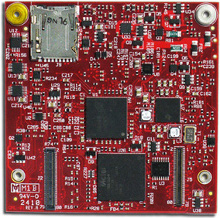

Fury (left) and Siren (right)
(Click on either to enlarge)
The DaVinci DM3730 followed in August. It is essentially the same as the AM3715, complete with the Imagination Technologies Powervr SG 2D/3D graphics accelerator, but adds a C64x+ DSP (digital signal processor), enabling 720p video and audio decoding, according to TI.
The DM3730 was chosen by BeagleBoard community as the SoC driving the new, Digi-Key distributed BeagleBoard-xM SBC. Both the DM3730 and AM3703 are also options in Direct Insight's SODIMM-sized SwiftModule-DM COM (computer on module). Despite the different Sitara and DaVinci family names, it would appear that the two SoCs are a matched set, and that the AM3715 will be used more sparingly by the embedded community for specialty purposes.
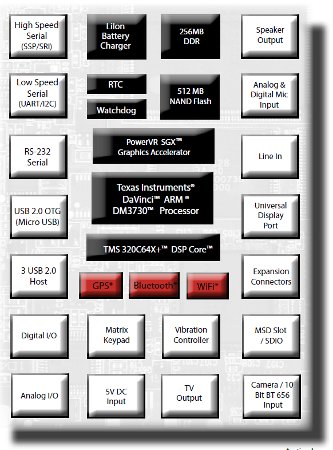
Fury block diagram
(Click to enlarge)
The Fury and Sire support display resolutions of up to 1400 x 1050, says InHand. The Muse daughtercard extends the video decode/encode capabilities of the respective SBCs and SoCs, and adds other video and camera capabilities. These include an RGB/component video input, a five-megapixel camera interface, a CMOS sensor, and NTSC/PAL output/input, says InHand. An LCD touchscreen with backlight appears to be available as accessories.
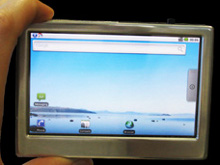
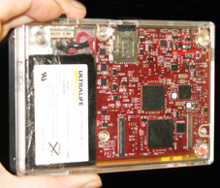
Fury with LCD module, front and back
The Fury and Siren each offer a RS-232 port onboard, while RS-232 and RS-485 ports are available on the daughtercard, says InHand. The Muse also provides I2C, SMbus, and GPIO, the company adds.
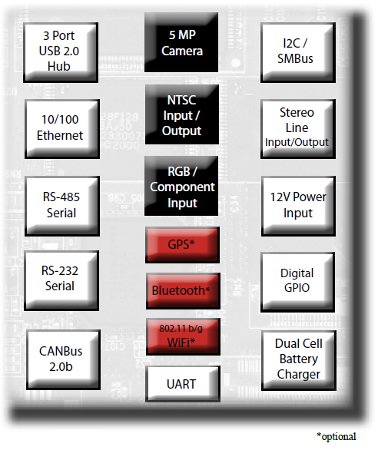
Muse daughtercard block diagram
(Click to enlarge)
Features and specifications listed for the Fury and Siren, with Muse daughtercard extensions noted, include:
- Processor — Texas Instruments DaVinci DM3730 (Fury) or Sitara AM3703 (Siren), each @ 1GHz
- Memory — 256MB DDR2 RAM
- Storage — 512MB NAND flash
- Expansion — microSD Slot/SDIO slot
- Display/camera
- up to SXGA+ (1400 x 1050) resolution
- LCD touchscreen and backlight available
- RGB/component video input on daughtercard
- camera interface for 5-Mpixel resolution
- CMOS sensor and NTSC/PAL output/input on daughtercard
- Networking — 10/100 Ethernet with RJ-45 connector (via daughtercard)
- Other I/O:
- 2 x USB 2.0 Host ports
- 1 x more USB 2.0 Host port on daughtercard
- 1 x microUSB OTG port
- 4-port USB 2.0 hub external accessory
- 1 x RS-232 serial port onboard, with RS-232 and RS-485 ports on daughtercard
- high-speed SSI/SPI interface
- low-speed UART/I2C interface, with UART connector on daughtercard
- digital and analog I/O pins with 16 GPIO pins (4 x interruptible) on daughtercard
- Wireless options:
- 802.11 b/g Wi-Fi
- Bluetooth 2.0
- 20-channel GPS module
- Audio I/O:
- speaker out
- headphone out
- analog mic in
- digital mic in
- line out (extended on daughtercard)
- line in (extended on daughtercard)
- Power:
- 500mW~750mW power consumption
- li-ion battery charger peripheral (on daughtercard)
- BatterySmart software
- Real-time clock (RTC)
- Dimensions:
- Fury and Siren — 2.5 x 2.5 inches (63.6 x 63.mm)
- Muse — 4.86 x 3.17 inches (123.6 x 80.7mm)
Stated Juan Gonzales, DaVinci video processors marketing manager for Texas Instruments, "The small size of Fury and Siren with their expansive list of peripherals, low-power excellence and full board support package combines with TI's long-standing focus on low-power, multimedia performance, and an expansive embedded processor portfolio to create an incredible opportunity for OEMs to easily create a great handheld, wireless device."
Availability
The Fury and the Siren will be available this fall, says InHand Electronics, which did not list pricing. More information on the Fury may be found here, and more on the Siren may be found here.
More on the Muse daughtercard may be found here.
This article was originally published on LinuxDevices.com and has been donated to the open source community by QuinStreet Inc. Please visit LinuxToday.com for up-to-date news and articles about Linux and open source.